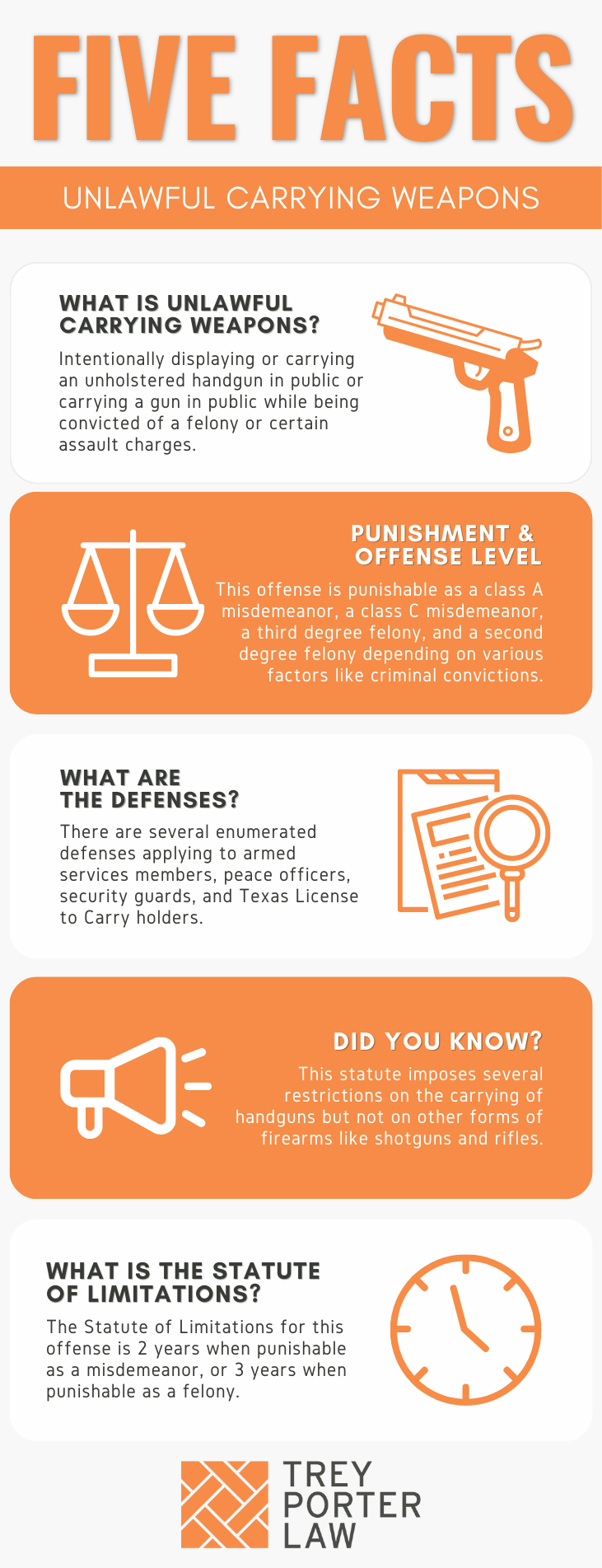WHAT IS THE OFFENSE OF UNLAWFUL CARRYING WEAPONS IN TEXAS?
The Texas law against unlawfully carrying a weapon, commonly referred to as “UCW” or “unlawful carrying,” prohibits Texans from carrying handguns and large knives in limited circumstances.
House Bill 1927, known as Texas’s “Constitutional Carry” law, became effective in September of 2021. Constitutional Carry repealed and amended a series of laws against carrying handguns in most places without a license, and legalized carrying handguns in most locations.
- Who cannot carry a gun in Texas? Convicted felons are prohibited from having any type of firearm whatsoever if it has been less than five years since their release from prison, parole, probation, or other supervision after their felony conviction. After the five-year period, they may only possess firearms in their homes. The UCW statute also restricts the right to carry of certain persons by only allowing them to have a handgun in their homes and vehicles. It is illegal to carry a handgun in a place other than one’s home or vehicle if the person is:
-
- under 21 years old;
- intoxicated;
- subject to a protective order; or
- convicted within the preceding five years for:
- Is carrying a handgun in public legal in Texas? Yes, even without a license to carry, as long as the handgun is holstered or concealed. A person may only be arrested for UCW if he or she intentionally displays an unholstered gun, or is intoxicated or prohibited by other laws from carrying a firearm.Carrying a handgun or other weapon on premises where weapons are prohibited may be punished as a Class C misdemeanor under the trespassing statutes, or as a third degree felony under Section 46.03 listing places where weapons are prohibited.
- Is carrying a gun in a vehicle or watercraft legal in Texas? Yes. However, even if a person is legally permitted to carry a handgun, he or she may be arrested for UCW if the gun is in plain view, unholstered, or the person is engaging in criminal activity other than a traffic violation. If, for example, a person is stopped and arrested for driving while intoxicated, or possession of marijuana, police may add a UCW charge if there is a handgun in the car.
WHAT IS THE UNLAWFUL CARRYING WEAPONS LAW IN TEXAS?
Tex. Penal Code § 46.02. UNLAWFUL CARRYING WEAPONS.
(a) A person commits an offense if the person:
(1) intentionally, knowingly, or recklessly carries on or about his or her person a handgun;
(2) at the time of the offense:
(A) is younger than 21 years of age; or
(B) has been convicted of an offense under Section 22.01(a)(1), 22.05, 22.07, or 42.01(a)(7) or (8) committed in the five-year period preceding the date the instant offense was committed; and
(3) is not:
(A) on the person’s own premises or premises under the person’s control; or
(B) inside of or directly en route to a motor vehicle or watercraft that is owned by the person or under the person’s control.
(a-1) A person commits an offense if the person intentionally, knowingly, or recklessly carries on or about his or her person a handgun in a motor vehicle or watercraft that is owned by the person or under the person’s control at any time in which:
(1) the handgun is in plain view, unless the person is 21 years of age or older or is licensed to carry a handgun under Subchapter H, Chapter 411, Government Code, and the handgun is carried in a holster; or
(2) the person is:
(A) engaged in criminal activity, other than a Class C misdemeanor that is a violation of a law or ordinance regulating traffic or boating; or
(B) prohibited by law from possessing a firearm .
. . .
(a-4) A person commits an offense if the person:
(1) intentionally, knowingly, or recklessly carries on or about his or her person a location-restricted knife;
(2) is younger than 18 years of age at the time of the offense; and
(3) is not:
(A) on the person’s own premises or premises under the person’s control;
(B) inside of or directly en route to a motor vehicle or watercraft that is owned by the person or under the person’s control; or
(C) under the direct supervision of a parent or legal guardian of the person.
(a-5) A person commits an offense if the person carries a handgun and intentionally displays the handgun in plain view of another person in a public place. It is an exception to the application of this subsection that the handgun was partially or wholly visible but was carried in a holster.
(a-6) A person commits an offense if the person:
(1) carries a handgun while the person is intoxicated; and
(2) is not:
(A) on the person’s own property or property under the person’s control or on private property with the consent of the owner of the property; or
(B) inside of or directly en route to a motor vehicle or watercraft:
(i) that is owned by the person or under the person’s control; or
(ii) with the consent of the owner or operator of the vehicle or watercraft.
(a-7) A person commits an offense if the person:
(1) intentionally, knowingly, or recklessly carries on or about his or her person a handgun;
(2) is not:
(A) on the person’s own premises or premises under the person’s control; or
(B) inside of or directly en route to a motor vehicle or watercraft that is owned by the person or under the person’s control; and
(3) at the time of the offense, was prohibited from possessing a firearm under Section 46.04(a), (b), or (c).
(a-8) If conduct constituting an offense under Subsection (a-7) constitutes an offense under another provision of law, the actor may be prosecuted under Subsection (a-7) or under both provisions.
(b) Except as provided by Subsection (d) or (e), an offense under this section is a Class A misdemeanor.
. . .
(d) An offense under Subsection (a-4) is a Class C misdemeanor.
(e) An offense under Subsection (a-7) is:
(1) a felony of the second degree with a minimum term of imprisonment of five years, if the actor was prohibited from possessing a firearm under Section 46.04(a); or
(2) a felony of the third degree, if the actor was prohibited from possessing a firearm under Section 46.04(b) or (c).
Tex. Penal Code § 46.15. NONAPPLICABILITY.
(a) Sections 46.02 and 46.03 do not apply to:
(1) peace officers or special investigators under Article 2.122, Code of Criminal Procedure, and neither section prohibits a peace officer or special investigator from carrying a weapon in this state, including in an establishment in this state serving the public, regardless of whether the peace officer or special investigator is engaged in the actual discharge of the officer’s or investigator’s duties while carrying the weapon;
(2) parole officers, and neither section prohibits an officer from carrying a weapon in this state if the officer is:
(A) engaged in the actual discharge of the officer’s duties while carrying the weapon; and
(B) in compliance with policies and procedures adopted by the Texas Department of Criminal Justice regarding the possession of a weapon by an officer while on duty;
(3) community supervision and corrections department officers appointed or employed under Section 76.004, Government Code, and neither section prohibits an officer from carrying a weapon in this state if the officer is:
(A) engaged in the actual discharge of the officer’s duties while carrying the weapon; and
(B) authorized to carry a weapon under Section 76.0051, Government Code;
(4) an active judicial officer as defined by Section 411.201, Government Code, who is licensed to carry a handgun under Subchapter H, Chapter 411, Government Code;
(5) an honorably retired peace officer or other qualified retired law enforcement officer, as defined by 18 U.S.C. Section 926C, who holds a certificate of proficiency issued under Section 1701.357, Occupations Code, and is carrying a photo identification that is issued by a federal, state, or local law enforcement agency, as applicable, and that verifies that the officer is an honorably retired peace officer or other qualified retired law enforcement officer;
(6) the attorney general or a United States attorney, district attorney, criminal district attorney, county attorney, or municipal attorney who is licensed to carry a handgun under Subchapter H, Chapter 411, Government Code;
(7) an assistant United States attorney, assistant attorney general, assistant district attorney, assistant criminal district attorney, or assistant county attorney who is licensed to carry a handgun under Subchapter H, Chapter 411, Government Code;
(8) a bailiff designated by an active judicial officer as defined by Section 411.201, Government Code, who is:
(A) licensed to carry a handgun under Subchapter H, Chapter 411, Government Code; and
(B) engaged in escorting the judicial officer;
(9) a juvenile probation officer who is authorized to carry a firearm under Section 142.006, Human Resources Code; or
(10) a person who is volunteer emergency services personnel if the person is:
(A) carrying a handgun under the authority of Subchapter H, Chapter 411, Government Code; and
(B) engaged in providing emergency services.
(b) Sections 46.02, 46.03(a)(14), and 46.04(a-1) do not apply to a person who:
(1) is in the actual discharge of official duties as a member of the armed forces or state military forces as defined by Section 437.001, Government Code, or as a guard employed by a penal institution;
(2) is traveling;
(3) is engaging in lawful hunting, fishing, or other sporting activity on the immediate premises where the activity is conducted, or is en route between the premises and the actor’s residence, motor vehicle, or watercraft, if the weapon is a type commonly used in the activity;
(4) holds a security officer commission issued by the Texas Private Security Board, if the person is engaged in the performance of the person’s duties as an officer commissioned under Chapter 1702, Occupations Code, or is traveling to or from the person’s place of assignment and is wearing the officer’s uniform and carrying the officer’s weapon in plain view;
(5) acts as a personal protection officer and carries the person’s security officer commission and personal protection officer authorization, if the person:
(A) is engaged in the performance of the person’s duties as a personal protection officer under Chapter 1702, Occupations Code, or is traveling to or from the person’s place of assignment; and
(B) is either:
(i) wearing the uniform of a security officer, including any uniform or apparel described by Section 1702.323(d), Occupations Code, and carrying the officer’s weapon in plain view; or
(ii) not wearing the uniform of a security officer and carrying the officer’s weapon in a concealed manner;
(6) is carrying:
(A) a license issued under Subchapter H, Chapter 411, Government Code, to carry a handgun; and
(B) a handgun:
(i) in a concealed manner; or
(ii) in a holster;
(7) holds an alcoholic beverage permit or license or is an employee of a holder of an alcoholic beverage permit or license if the person is supervising the operation of the permitted or licensed premises; or
(8) is a student in a law enforcement class engaging in an activity required as part of the class, if the weapon is a type commonly used in the activity and the person is:
(A) on the immediate premises where the activity is conducted; or
(B) en route between those premises and the person’s residence and is carrying the weapon unloaded.
. . .
(d) The provisions of Section 46.02 prohibiting the carrying of a firearm do not apply to a public security officer employed by the adjutant general under Section 437.053, Government Code, in performance of official duties or while traveling to or from a place of duty.
(e) Section 46.02(a-4) does not apply to an individual carrying a location-restricted knife used in a historical demonstration or in a ceremony in which the knife is significant to the performance of the ceremony.
(f) Section 46.03(a)(6) does not apply to a person who possesses a firearm or club while in the actual discharge of official duties as:
(1) a member of the armed forces or state military forces, as defined by Section 437.001, Government Code; or
(2) an employee of a penal institution.
(g) The provisions of Section 46.03 prohibiting the possession or carrying of a club do not apply to an animal control officer who holds a certificate issued under Section 829.006, Health and Safety Code, and who possesses or carries an instrument used specifically for deterring the bite of an animal while the officer is in the performance of official duties under the Health and Safety Code or is traveling to or from a place of duty.
(h) The provisions of Section 46.03 prohibiting the possession or carrying of a club do not apply to a code enforcement officer who:
(1) holds a certificate of registration issued under Chapter 1952, Occupations Code; and
(2) possesses or carries an instrument used specifically for deterring an animal bite while the officer is:
(A) performing official duties; or
(B) traveling to or from a place of duty.
. . .
(j) The provisions of Sections 46.02 and 46.03(a)(7), (a-2), (a-3), and (a-4) do not apply to an individual who carries a handgun as a participant in a historical reenactment performed in accordance with the rules of the Texas Alcoholic Beverage Commission.
(k) Section 46.02 does not apply to a person who carries a handgun if:
(1) the person carries the handgun while:
(A) evacuating from an area following the declaration of a state of disaster under Section 418.014, Government Code, or a local state of disaster under Section 418.108, Government Code, with respect to that area; or
(B) reentering that area following the person’s evacuation;
(2) not more than 168 hours have elapsed since the state of disaster or local state of disaster was declared, or more than 168 hours have elapsed since the time the declaration was made and the governor has extended the period during which a person may carry a handgun under this subsection; and
(3) the person is not prohibited by state or federal law from possessing a firearm.
(l) Sections 46.02 and 46.03(a)(1), (a)(2), (a)(3), and (a)(4) do not apply to a person who carries a handgun if:
(1) the person carries the handgun on the premises, as defined by the statute providing the applicable offense, of a location operating as an emergency shelter during a state of disaster declared under Section 418.014, Government Code, or a local state of disaster declared under Section 418.108, Government Code;
(2) the owner, controller, or operator of the premises or a person acting with the apparent authority of the owner, controller, or operator, authorized the carrying of the handgun;
(3) the person carrying the handgun complies with any rules and regulations of the owner, controller, or operator of the premises that govern the carrying of a handgun on the premises; and
(4) the person is not prohibited by state or federal law from possessing a firearm.
<Text of (m), as added by Acts 2021, 87th Leg., ch. 809 (H.B. 1927), § 25>
(m) It is a defense to prosecution under Section 46.03 that the actor:
(1) carries a handgun on a premises or other property on which the carrying of a weapon is prohibited under that section;
(2) personally received from the owner of the property, or from another person with apparent authority to act for the owner, notice that carrying a firearm or other weapon on the premises or other property, as applicable, was prohibited; and
(3) promptly departed from the premises or other property.
<Text of (m), as added by Acts 2021, 87th Leg., ch. 1026 (H.B. 1069), § 8>
(m) Sections 46.02, 46.03, and 46.035(b) and (c) do not apply to a first responder who:
(1) was carrying a handgun in a concealed manner or in a shoulder or belt holster;
(2) holds an unexpired certificate of completion under Section 411.184, Government Code, at the time of engaging in the applicable conduct;
(3) was engaged in the actual discharge of the first responder’s duties while carrying the handgun; and
(4) was employed or supervised by a municipality or county to which Chapter 179, Local Government Code, applies.
(n) The defense provided by Subsection (m) does not apply if:
(1) a sign described by Subsection (o) was posted prominently at each entrance to the premises or other property, as applicable; or
(2) at the time of the offense, the actor knew that carrying a firearm or other weapon on the premises or other property was prohibited.
(o) A person may provide notice that firearms and other weapons are prohibited under Section 46.03 on the premises or other property, as applicable, by posting a sign at each entrance to the premises or other property that:
(1) includes language that is identical to or substantially similar to the following: “Pursuant to Section 46.03, Penal Code (places weapons prohibited), a person may not carry a firearm or other weapon on this property”;
(2) includes the language described by Subdivision (1) in both English and Spanish;
(3) appears in contrasting colors with block letters at least one inch in height; and
(4) is displayed in a conspicuous manner clearly visible to the public.
(p) Sections 46.03(a)(7), (11), and (13) do not apply if the actor:
(1) carries a handgun on the premises or other property, as applicable;
(2) holds a license to carry a handgun issued under Subchapter H, Chapter 411, Government Code; and
(3) was not given effective notice under Section 30.06 or 30.07 of this code or Section 411.204, Government Code, as applicable.
(q) Section 46.03(a)(8) does not apply if the actor:
(1) carries a handgun on a premises where a collegiate sporting event is taking place;
(2) holds a license to carry a handgun issued under Subchapter H, Chapter 411, Government Code; and
(3) was not given effective notice under Section 30.06 or 30.07 of this code, as applicable.
WHAT IS THE PENALTY CLASS FOR UNLAWFUL CARRYING WEAPONS IN TEXAS?
By default, unlawful carrying is a Class A misdemeanor, punishable by up to one year in county jail. Carrying a knife with a blade over five and a half inches is a Class C misdemeanor, punishable by a maximum fine of $500, for people who are:
- under 18;
- not on their own premises, premises under their control, or in or directly en route to their vehicle; and
- not under a parent’s or guardian’s direct supervision.
Convicted felons who carry handguns in violation of Section 46.04(a) also commit a second degree felony under the UCW statute, punishable by five to 20 years in prison.
Pursuant to Section 46.04(a), convicted felons may not possess firearms within five years of their release from prison, parole, probation, or other supervision after a felony conviction. They may have firearms in their homes after the five-year period since their release, but may not carry guns anywhere outside their home.
It is a third degree felony, punishable by two to ten years in prison, to carry a handgun if prohibited from possessing firearms by Section 46.04(b) or (c).
- Section 46.04(b), prohibits people convicted of assault causing bodily injury under Penal Code Section 22.01(a)(1) against a family or household member may not possess firearms within five years of their release from confinement or community supervision.
- Section 46.04(c) prohibits persons subject to a protective order issued by a judge or magistrate under the Texas Family Code or Texas Code of Criminal Procedure from possessing firearms while the order is in effect.
Texas Penal Code Section 46.11 increases the punishment to the next highest category if the person committed a weapons offense within 300 feet of a school, or on premises where a school function or an event sponsored by the University Scholastic League is taking place. This section does not apply to a person charged with bringing a handgun on school premises under 46.03(a)(1).
WHAT IS THE PUNISHMENT RANGE FOR UNLAWFUL CARRYING WEAPONS IN TEXAS?
A Class A misdemeanor UCW charge carries up to one year in jail, and a maximum fine of $4,000. Minors charged with carrying a location-restricted knife, a Class C misdemeanor, face a maximum fine of $500.
A third degree felony UCW charge for persons subject to a protective order carries between two and ten years in prison, and a maximum fine of $10,000. Convicted felons charged with UCW as a second degree felony face five to 20 years in prison, and a maximum $10,000 fine.
WHAT ARE THE PENALTIES FOR UNLAWFUL CARRYING WEAPONS IN TEXAS?
A person charged with UCW may be eligible for probation after a conviction, or deferred adjudication without a conviction. A minor charged with carrying a knife with a blade over five and a half inches, a Class C misdemeanor, may be placed on deferred adjudication for a maximum period of 180 days.
The maximum period of probation or deferred adjudication for a Class A misdemeanor is two years, and ten years for a second degree or third degree felony.
WHAT ARE THE DEFENSES TO UNLAWFUL CARRYING WEAPONS IN TEXAS?
There are several defenses and exceptions to an unlawful carrying charge. Penal Code Section 46.15 lists scenarios to which the unlawful carrying statute does not apply. For example, members of the armed forces or national guard, or a guard employed by a penal institution who are discharging their official duties may raise a defense if they are arrested for unlawfully carrying a firearm.
Another defense is available for security officers who are arrested openly carrying a firearm or club at a racetrack, while in uniform, if they show they were traveling to or from a place of assignment or discharging duties as a security officer.
- Can a person with a license to carry a handgun carry into places otherwise prohibited by Texas law? A person with a license to carry (“LTC”) is not exempt from the law prohibiting weapons in certain protected places. However, the statute permits LTC holders to carry a concealed handgun onto school grounds, college campuses, and any other institution of higher education, unless the campus or institution provides effective notice under Section 30.06 that firearms are prohibited.Even where they are allowed to carry, LTC holders must carry concealed on campus grounds and the surrounding outdoor areas, such as parking lots and sidewalks. Displaying a handgun on campus is a Class A misdemeanor.
- May a listed prohibited place allow firearms on the premises in Texas? Government courts and court offices, schools, hospitals, and nursing facilities may permit weapons on premises, through their written regulations or other written authorization. The other locations listed in the statute may not circumvent the weapons prohibition.
- Are guns and other weapons prohibited inside the airport in Texas? Yes, but the law creates defenses, which may be raised and proved at a person’s trial for possessing a prohibited weapon in a secured area of an airport. The statute gives LTC holders a defense if they exit the screening checkpoint immediately upon being notified of the handgun in their possession, and prohibits police from arresting them prior to giving them the opportunity to exit the area. Additional defenses are available for:
-
- travelers who check all firearms as baggage prior to entering the secured area, or were authorized by a federal agency or airport operator to carry a firearm;
- security officers, members of the armed forces or national guard, or guards employed by a penal institution who openly carry a firearm or club while traveling to or from their place of assignment, or discharging duties, and are in uniform;
- security officers with personal protection authorization, who either openly carry a firearm while in uniform, or concealed carry a firearm if not in uniform.
WHAT IS THE STATUTE OF LIMITATIONS FOR UNLAWFUL CARRYING WEAPONS IN TEXAS?
The limitation period for Class A misdemeanor UCW is two years. If the unlawful carrying charge is categorized as a felony, the limitation period is three years.
UNLAWFUL CARRYING WEAPONS IN TEXAS
Carrying handguns in public places, whether openly carried or concealed, has gained widespread national acceptance. Texas is a self-proclaimed “Second Amendment sanctuary state,” according to Texas Penal Code Section 1.10, which means Texas law enforcement officers are prohibited from enforcing federal gun control regulations.
TEXAS UNLAWFUL CARRYING WEAPONS COURT CASES
The case law regarding unlawful carrying weapons in Texas shows courts refusing to enforce certain prohibitions on handguns, declaring most restrictions unconstitutional.
- In New York State Rifle & Pistol Association, Inc. v. Bruen, the United States Supreme Court reiterated the Second Amendment protection of an individual’s right to keep and bear arms, especially for self-defense, and the Fourteenth Amendment’s prohibition on states enacting laws infringing upon that right. The Court held New York’s restriction on publicly carrying handguns was unconstitutional, and explained every law-abiding citizen has the right to carry a handgun, without an unduly burdensome and expensive application process.
- In United States v. Rahimi, the Fifth Circuit declared a federal law prohibiting handgun possession with an active protective order, 18 U.S.C. § 922(g)(8), unconstitutional in light of Bruen.
- In Firearms Policy Coalition, Inc. v. McGraw, a United States District Court held the provision of UCW statute prohibiting most law-abiding citizens under 21 years old from carrying a handgun was unconstitutional.

















